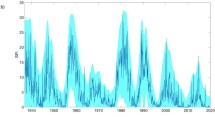Abstract
The latitudinal-temporal changes in wavelet spectra for the number of coronal bright points (CBPs) in solar-activity (SA) cycles 23 and 24 are analyzed with the Morlet function. The number of CBPs at different latitudes is found to vary in different ways. The changes in the total number of CBPs show no noticeable relation with SA cycles. Conversely, the distribution of the spectral density of the CBP number at active and high latitudes and the equator, as well as the total CBP number, shows a pronounced agreement with the course of the SA cycle. An anticorrelation is observed for the high latitude zone.



Similar content being viewed by others
REFERENCES
Chandrashekhar, K. and Sarkar, A., Modeling solar coronal bright-point oscillations with multiple nanoflare heated loops, Astrophys. J., 2015, vol. 810, no. 2, p. 163. https://doi.org/10.1088/0004-637X/810/2/163
Clette, F., Hochedez, J.F., Newmark, J.S., et al., The radiometric calibration of the extreme ultraviolet imaging telescope, in The Radiometric Calibration of SOHO (ISSI Scientific Reports Series), Pauluhn, A., Huber, M.C.E., and von Steiger, R., Eds., Bern: ISSI, 2002, pp. 121–134.
Delaboudinière, J.P., Artzner, G.E., Gabriel, A.H., et al., EIT: Extreme-ultraviolet imaging telescope for the SOHO mission, Sol. Phys., 1995, vol. 162, nos. 1–2, pp. 291–312. https://doi.org/10.1007/BF00733432
Egamberdiev, S.A., The placement of X-ray bright points relative to the chromospheric network, Sov. Astron. Lett., 1983, vol. 9, pp. 385–387.
Egamberdiev, Sh.A., Yakovkin, N.A., and Zel’dina, M.Yu., Helium ionization at bright X-ray points on the Sun, Izv. Akad. Nauk UzSSR, Fiz.–Mat. Nauki, 1983, no. 5, pp. 59–63.
Feldman, U., Doschek, G.A., Schühle, U., and Wilhelm, K., Properties of quiet-Sun coronal plasmas at distances of 1.03 ≤ R solar ≤ 1.50 along the solar equatorial plane, Astrophys. J., 1999, vol. 518, no. 1, pp. 500-507. https://doi.org/10.1086/307252
Golub, L., Krieger, A.S., Silk, J.K., et al., Solar X-ray bright points, Astrophys. J., 1974, vol. 189, pp. L93–L97. https://doi.org/10.1086/181472
Habbal, S.R., Withbroe, G.L., and Dowdy, J.F., A comparison between bright points in a coronal hole and a quiet-Sun region, Astrophys. J., 1990, vol. 352, pp. 333–342. https://doi.org/10.1086/168540
Krieger, A.S., Vaiana, G.S., and van Speybroeck, L.P., The X-ray corona and the photospheric magnetic field, in Solar Magnetic Fields (International Astronomical Union Symposium no. 43, Paris, France, August 31 to September 4, 1970), Howard, R.F., Ed., Dordrecht: Springer, 1971, pp. 397–412.
Madjarska, M.S., Doyle, J.G., Teriaca, L., and Banerjee, D., An EUV bright point as seen by SUMER, CDS, MDI and EIT on-board SOHO, Astron. Astrophys., 2003, vol. 398, pp. 775–784. https://doi.org/10.1051/0004-6361:20021732
Sattarov, I., Pevtsov, A., Karachik, N., and Sattarova, B.J., Large-scale structures in distribution of coronal bright points, in Large-Scale Structures and Their Role in Solar Activity (ASP Conference Series), 2005, vol. 346, pp. 363–368.
Sattarov, I., Pevtsov, A., Karachik, N., et al., Solar cycle 23 in coronal bright points, Sol. Phys., 2010, vol. 262, no. 2, pp. 321–335. https://doi.org/10.1007/s11207-010-9524-5
Sheeley, N.R., Jr. and Golub, L., Rapid changes in the fine structure of a coronal bright point and a small coronal active region, Sol. Phys., 1979, vol. 63, no. 1, pp. 119–126. https://doi.org/10.1007/BF00155702
Sherdanov, Ch.T., Minenko, E.P., Tillaboev, A.M., and Sattarov, I., Two types of coronal bright points in the 24-th cycle of solar activity, in The Sun: New Challenges, Astrophysics and Space Science Proceedings, Berlin: Springer, 2012, vol. 30, pp. 197–202. https://doi.org/10.1007/978-3-642-29417-4_18
Tian, H., Xia, L.-D., and Li, S., Long-period oscillations in solar coronal bright points, Astron. Astrophys., 2008, vol. 489, no. 2, pp. 741–745. https://doi.org/10.1051/0004-6361:200810146
Torrence, C. and Compo, G.P., A practical guide to wavelet analysis, Bull. Am. Meteorol. Soc., 1998, vol. 79, no. 1, pp. 61–78. https://doi.org/10.1175/1520-0477(1998)079<0061:APGTWA>2.0.CO;2
Ugarte-Urra, I., Dissertation talk: Brightness and magnetic evolution of solar coronal bright points, American Geophysical Union, Spring Meeting, 2005, abstract is SP22A-01.
Ugarte-Urra, I., Doyle, J.G., Madjarska, M.S., and O’Shea, E., Signature of oscillations in coronal bright points, Astron. Astrophys., 2004a, vol. 418, pp. 313–324. https://doi.org/10.1051/0004-6361:20035666
Ugarte-Urra, I., Doyle, J.G., Nakariakov, V.M., and Foley, C.R., CDS wide slit time-series of EUV coronal bright points, Astron. Astrophys., 2004b, vol. 425, pp. 1083–1095. https://doi.org/10.1051/0004-6361:20041069
Vaiana, G.S., Davis, J.M., Giacconi, R., et al., X-ray observations of characteristic structures and time variations from the solar corona: Preliminary results from SKYLAB, Astrophys. J. Lett., 1973, vol. 185, no. 1, pp. L47–L51. https://doi.org/10.1086/181318
Webb, D.F., Martin, S.F., Moses, D., and Harvey, J.W., The correspondence between X-ray bright points and evolving magnetic features in the quiet Sun, Sol. Phys., 1993, vol. 144, pp. 15–35. https://doi.org/10.1007/BF00667979
ACKNOWLEDGMENTS
The data used in this paper is freely available from the archives of the SOHO mission (https://soho.nascom. nasa.gov/data/archive/) and the International Sunspot Index Center in Brussels (SIDC, RWC Belgium, World Data Center for the Sunspot Index, Royal Observatory of Belgium, SILSO, Sunspot Index and Long-term Solar Observations, http://sidc.be/silso). The authors are grateful to the teams of these projects.
Funding
The work was supported by the Astronomical Institute, Academy of Sciences of Uzbekistan, grant no. VA-FA-F-2-009.
Author information
Authors and Affiliations
Corresponding author
Ethics declarations
The authors declare that they have no conflicts of interest.
Additional information
Translated by A. Ivanov
Rights and permissions
About this article
Cite this article
Minenko, E.P., Ehgamberdiev, S.A. Latitudinal-Temporal Analysis of Long-Periodic Variations of Coronal Bright Points. Geomagn. Aeron. 61, 1128–1134 (2021). https://doi.org/10.1134/S0016793221080168
Received:
Revised:
Accepted:
Published:
Issue Date:
DOI: https://doi.org/10.1134/S0016793221080168




